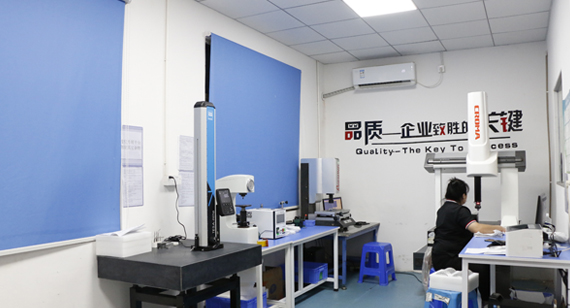15 years one-stop China custom CNC machining parts factory

Hey there I’m VMT Sam!
With 25 years of CNC machining experience we are committed to helping clients overcome 10000 complex part-processing challenges all to contribute to a better life through intelligent manufacturing. Contact us now
 131 |
Published by VMT at Feb 16 2024
131 |
Published by VMT at Feb 16 2024
Description:
In the manufacturing industry, the widespread application of aluminum CNC machined parts is attributed to their lightweight, high strength, and excellent corrosion resistance. However, the quality of surface treatment directly influences the appearance, performance, and durability of these parts. To ensure the quality of surface treatment for aluminum CNC machined parts, it is crucial to establish effective control measures and standards. This article explores how to develop effective control measures and standards for the surface treatment of aluminum CNC machined parts.

Section 1: Surface Treatment Control Measures
Surface Pretreatment:
Surface pretreatment is a crucial step in ensuring surface treatment quality. Its purpose is to remove oil, impurities, and oxide layers from the part's surface to enhance the adhesion between the coating and the substrate. Common pretreatment methods include mechanical cleaning, chemical cleaning, and sandblasting. The selection of the appropriate pretreatment method should consider the material, structure, and usage requirements of the part.

Selection of Suitable Coating Materials:
The choice of coating materials directly impacts the surface performance of aluminum CNC machined parts. Coating materials should possess excellent corrosion resistance, wear resistance, and aesthetics. Compatibility between the coating material and the substrate material should also be ensured to enhance adhesion.

Coating Process Control:
Controlling the coating process is a critical aspect of ensuring surface treatment quality. Detailed coating process procedures should be established, specifying parameters such as coating thickness, application methods, and drying conditions. Real-time monitoring of process parameters during coating is essential to ensure compliance with process requirements. Control limits should be set for key process parameters, with adjustments or rework conducted promptly if limits are exceeded.
Quality Inspection and Control:
Quality inspection and control are necessary means to ensure the surface treatment quality of aluminum CNC machined parts. A comprehensive quality inspection plan should be developed, covering aspects such as coating appearance, thickness, adhesion, etc. Non-destructive testing techniques, such as fluorescent penetrant testing and X-ray inspection, should be employed for critical items to ensure the intrinsic quality of parts. Regular calibration and maintenance of inspection equipment are essential to ensure the accuracy and reliability of inspection results.

Section 2: Standardization Measures
Establishing Clear Operating Procedures:
To standardize the surface treatment operations of aluminum CNC machined parts, clear operating procedures should be established. These procedures should include process flows, equipment operations, safety precautions, etc. Quality requirements and inspection standards for each process should be clearly defined. Through employee training, ensure proficiency in operating procedures and strict adherence to relevant regulations.
Reinforcing Process Control and Management:
Process control and management are crucial to guarantee the quality of surface treatment. Monitoring the entire surface treatment process to ensure compliance with process requirements is essential. Quality control points should be set for critical processes, with real-time monitoring and recording of key process parameters. Regular statistical analysis of process control data should be performed to detect and address potential quality issues promptly.
Establishing a Comprehensive Inspection System:
Establishing a comprehensive inspection system is a necessary means to ensure the quality of surface treatment for aluminum CNC machined parts. Detailed inspection procedures should be developed, specifying inspection items, methods, frequencies, and acceptance criteria. Inspection personnel should possess the necessary skills and qualifications to accurately judge product quality. Non-conforming products should undergo traceability and rework, with the analysis of reasons and implementation of corrective measures.
Regular Maintenance of Equipment:
The performance and accuracy of equipment directly impact the surface treatment quality of aluminum CNC machined parts. A maintenance and lubrication plan for equipment should be established, including regular cleaning, lubrication, and inspection. For critical equipment, regular precision calibration and maintenance should be conducted to ensure normal operation and effectiveness. Additionally, records and analysis of equipment faults should be maintained, and preventive measures should be taken to reduce equipment failure rates.
Section 3: Continuous Improvement and Innovation
Continuous Improvement:
Continuous improvement of surface treatment technology is essential to adapt to changing market demands. Companies should stay informed about industry trends and technological innovations, continually introducing new technologies, processes, and materials to enhance the quality and efficiency of surface treatment.
Optimization of Existing Processes:
Actively engage in the continuous improvement and optimization of existing processes to reduce costs and enhance product competitiveness. Collaborate with research institutions and universities to promote collaborative innovation and provide strong support for enterprise innovation.
Section 4: Training and Personnel Management
Training New Employees:
Systematic training for new employees is essential to familiarize them with the surface treatment processes, equipment operations, maintenance, safety precautions, etc. A combination of theoretical learning and practical exercises ensures that new employees acquire the necessary skills and knowledge.
Ongoing Training and Development:
Regular training for existing employees is necessary to upgrade skills and knowledge. Training content can be customized based on job requirements and skill levels, focusing on practical operations, problem-solving, and teamwork. Encourage employees to participate in external training and exchange activities to broaden their perspectives and enhance their overall qualities.
Performance Evaluation and Incentive Mechanism:
Establishing a performance evaluation and incentive mechanism helps boost employee motivation and work quality. Assessing employee performance and providing corresponding rewards or penalties encourages a sense of responsibility and enthusiasm. Address employee needs and development by offering good career development opportunities and promotion pathways to enhance their sense of belonging and loyalty.
Section 5: Quality Management System Construction
Quality Policy and Objectives:
Formulate clear quality policies and objectives to provide guiding principles and direction for enterprise quality management. The quality policy should include the company's commitment to product quality, quality management principles, and pursuit of goals. Quality objectives should be specific, measurable, achievable, and regularly evaluated and updated.
Documenting the Quality Management System:
Establish a comprehensive quality management system documentation, including quality manuals, procedural documents, operating instructions, etc., to clarify the responsibilities and operational requirements of each department and position. Documented management ensures the standardization of quality management work.
Operation and Monitoring of the Quality Management System:
Ensure the effective operation of the quality management system by conducting regular internal audits and management reviews, examining the conformity and effectiveness of the quality management system. Strengthen process monitoring and data analysis to promptly detect and resolve potential quality issues.
Continuous Improvement:
Achieve continuous improvement of the quality management system to enhance product quality and customer satisfaction continually. Encourage employees to propose improvement ideas and suggestions, actively adopt effective improvement measures, and optimize production processes and operating methods. Keep abreast of industry and international standards, updating and improving the enterprise quality management system as necessary.
Conclusion:
Developing effective control measures and standards for the surface treatment of aluminum CNC machined parts is crucial for enhancing product quality, reducing production costs, and increasing competitiveness. By establishing a sound quality management system, reinforcing process control and management, focusing on training and personnel management, and embracing continuous improvement and innovation, companies can elevate the management level and work quality of surface treatment for aluminum CNC machined parts comprehensively. Additionally, companies should stay attuned to industry dynamics.
Ready To Start Your Next Project?
Get Instant Quote

Request a Free Quote
Send us a message if you have any questions or request a quote. We will get back to you ASAP!